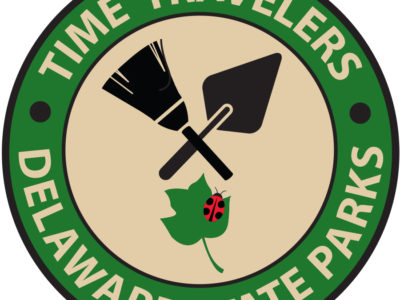
Time Traveling in Delaware State Parks
About a year and a half ago, at the end of my first week as the new Cultural Preservation Specialist at Delaware State Parks, my new boss said to me, “Er, John, did I tell you about Time Travelers?” Warily, I replied, “No, Jim, what’s that?” “It’s the volunteer program we used to have. You’ll need to revive it.” “Oh,” I said, “I think you neglected to mention that during the interview.”

I was initially daunted by the thought of having to run a volunteer program. I had been a volunteer myself early in my career and had worked with volunteers in some of my positions since then. I had considerable respect for volunteers. However, I also had a certain disdain for the idea that archaeology was something my agency could think that they did not have to pay to have performed on its behalf. After all, Parks did not engage “volunteer” engineers to design new restrooms or parking lots.
While I saw a role for the interested public, under professional supervision, to assist with some of the small scale compliance projects that my office engages in, from the outset I considered Time Travelers to be a program of enrichment, not of free labor. Volunteer labor is never completely free. Volunteers need training, supervision, and the knowledge that their contributions of time and energy are recognized and valued. The volunteer should get as much out of the experience as the agency gets in labor value.

I eventually found some documentation for the Time Traveler program as it had existed from the mid 1990s to the early 2000s. It was billed as a “hands-on heritage experience for the public.” There was a hierarchy of Recruits, Apprentices, Regular Time Travelers, Warrant Officers, Mission Leaders, and Mission Specialists, and I thought, “Ack! They expect me to recreate Star Fleet!”
What I came up with was a two-pronged approach. While Time Travelers would be reestablished as a volunteer program for hands-on archaeology and other cultural heritage-related activities, it would also be a branding effort for cultural heritage-themed programs and events in the parks. This would give cultural heritage programs a unified identity and connect those programs to hands-on, participatory opportunities.
I was also lucky that the Archaeological Society of Delaware (ASD) had on-going archaeological research projects and a bevy of experienced volunteers that I could cross-recruit to be Time Traveler volunteers. In our first field projects ASD members made up the bulk of the teams, but not exclusively so. Experienced veterans guided those with little to no experience. Fieldwork entailed detailed briefings of goals, objectives, methods, and anticipated results of these small (four- to six-person) teams that I closely supervised. Field days are kept short and even mildly adverse weather postpones the work.

I also developed a Basic Archaeology Class for Time Travelers. The class covers preservation ethics, key archaeological concepts and terms, and a review of the methods we use and why we use them. Those who survive about three hours of my lectures and who then demonstrate the ability to excavate a shovel test were awarded a newly designed embroidered Time Traveler logo patch and a certificate signed by both myself and the Director of State Parks. The class has been offered twice now and the cadre of Time Travelers has grown to nearly 50 and includes high school students to retired seniors.
While Time Travelers do some compliance-related work, the bulk of the activity is research-oriented and often non-destructive, such as a recent metal-detector survey of the late 19th-century Quarantine Station at Cape Henlopen State Park where “hits” were flagged, ground-truthing was limited, and nothing was collected. The major result was confirmation that the facilities had not been burned or bull-dozed when abandoned, but apparently carefully salvaged since the debris signatures were very faint.
Time Traveler volunteers have so far assisted with over a dozen small projects and three larger on-going projects.
As the program matures, opportunities for specialized training will be developed, such as historic and prehistoric artifact identification, artifact processing and laboratory practices, and geophysical remote sensing. And I have so many ideas for research projects that the public will find exciting to be a part of.




